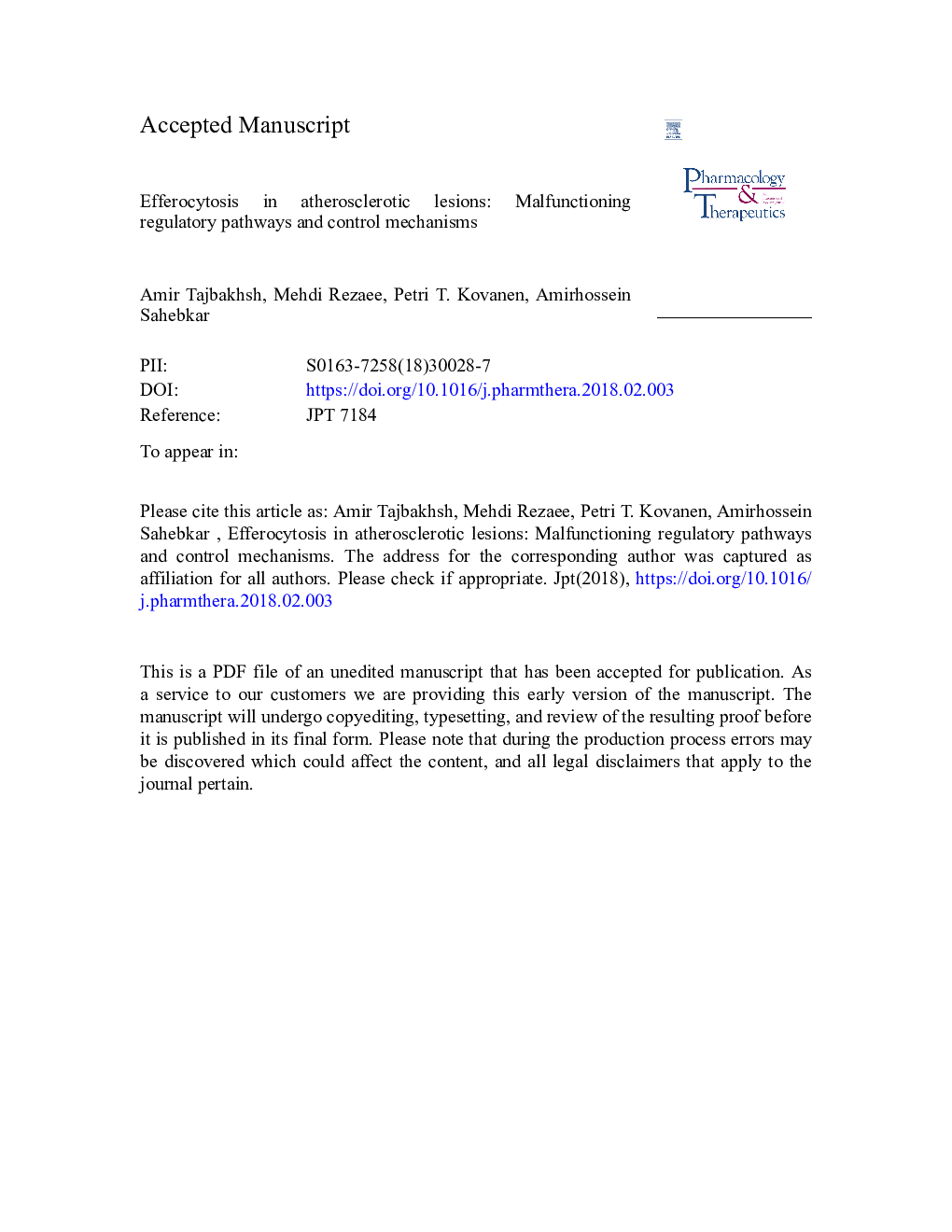| کد مقاله | کد نشریه | سال انتشار | مقاله انگلیسی | نسخه تمام متن |
|---|---|---|---|---|
| 8536781 | 1560917 | 2018 | 36 صفحه PDF | دانلود رایگان |
عنوان انگلیسی مقاله ISI
Efferocytosis in atherosclerotic lesions: Malfunctioning regulatory pathways and control mechanisms
دانلود مقاله + سفارش ترجمه
دانلود مقاله ISI انگلیسی
رایگان برای ایرانیان
کلمات کلیدی
ABCSirt1NF-κBPI3KAICARLPSERK5ABSHDLACSDAMPqRT-PCRMCP-1ABCA1PPARSPMLPCSRFIL-10HSPsDCsTLRS1PARG1HMGB15-LOXUCP2CD14TRAF6RAGELRP1CHDEfferocytosismtROSRSVapoA1TG2TRPMannexin A5ANXA5MFG-E8SMCsSR-BIPTX3IL-12LXRArg2sirtuin1VSMCsoxLDLPtdSerABCG1G-protein–coupled receptorLOX-1ACVDTSP-1SIRPαTRPCIRF5THBSCDKN2BABCA7SMERG2AGvHDIgMTGF-βextracellular-signal-regulated kinase 5brain-specific angiogenesis inhibitor 1cyclin-dependent kinase inhibitor 2BATP binding cassette transporter G1Mer tyrosine kinase5-Lipoxygenase - 5-لیپوکسیژنازCa2+ - Ca2 +Mϕ - MφNOx - NOXarginase 1 - آرژیناز 1arginase 2 - آرژیناز 2antibodies - آنتی بادی هاMyocardial infarction - آنفارکتوس میوکاردApoe - آپوApolipoprotein A1 - آپولیپوپروتئین A1apolipoprotein E - آپولیپوپروتئین ESphingosine-1-phosphate - اسپینگسین-1-فسفاتinflammation - التهاب( توروم) damage-associated molecular patterns - الگوهای مولکولی مرتبط با آسیبNADPH oxidase - اکسیداز NADPH immunoglobulin M - ایمونوگلوبولین Minterleukin-12 - اینترلوکین -12Interleukin-10 - اینترلوکین 10coronary heart disease - بیماری عروق کرونر قلبcardiovascular disease - بیماری قلب و عروقیAtherosclerotic cardiovascular disease - بیماری قلبی عروقی AtheroscleroticGraft-versus-host disease - بیماری مرض در برابر میزبانtransforming growth factor-beta - تبدیل فاکتور رشد بتاTransglutaminase 2 - ترانس گلوتامیناز 2Thrombospondin - ترومبوزپوندینThrombospondin-1 - ترومبوسپوندن-1tumor necrosis factor-alpha - تومور نکروز عامل آلفاToll-like receptor - تیالآرcluster of differentiation - خوشه تمایزcluster of differentiation 14 - خوشه تمایز 14CVD - رسوب دهی شیمیایی بخار Resveratrol - رسوراترولquantitative reverse transcription-PCR - رونویسی معکوس PCRMERTK - زیراDendritic cells - سلول های دندریتیکVascular smooth muscle cells - سلول های عضلانی صاف عروقیSmooth muscle cells - سلول های عضله صافApoptotic cells - سلولهای آپوپتوزیSOC - سیستم روی یک تراشهinterferon regulatory factor 5 - عامل کنترل کننده اینترفرون 5TNF-α - فاکتور نکروز توموری آلفاnuclear factor kappa B - فاکتور هسته ای کاپا Bserum response factor - فاکتور پاسخ سرمیPhosphatidylserine - فسفاتیدیلسرینphosphoinositide 3-kinase - فسفینوزیتید 3-کینازPhytoalexin - فیتالکسینTREM - قطارLysophosphatidylcholine - لیزوفسفاتیدیل کولینhigh density lipoprotein - لیپوپروتئین با چگالی بالاOxidized low-density lipoprotein - لیپوپروتئین با چگالی کم اکسید شدهlipopolysaccharide - لیپوپلی ساکاریدMacrophage - ماکروفاژ MHC - مجموعه سازگاری بافتی اصلیmajor histocompatibility complex - مجموعه سازگاری بافتی اصلیMyocardin - میوکاردینNitric oxide - نیتریک اکسیدtransient receptor potential canonical - پتانسیل گیرنده گذرا کانونی استmonocyte chemotactic protein 1 - پروتئین chemotactic monocyte 1Signal regulatory protein α - پروتئین الگوریتم سیگنال αHigh-mobility group box 1 protein - پروتئین جعبه 1 پروتئین گروه تحریر بالاC-reactive protein - پروتئین واکنشی سیCRP - پروتئین واکنشی سی یا سی. آر. پی Heat shock proteins - پروتئینهای شوک حرارتیAtherosclerotic plaque - پلاک آترواسکلروزpentraxin 3 - پنتراکسین 3calr - کالرStore-operated channel - کانال ذخیره شدهliver X receptor - کبد X گیرندهcalreticulin - کلرتی کولینCalcium - کلسیمATP-binding cassette - کیت اتصال به ATPmitochondrial reactive oxygen species - گونه های اکسیژن واکنش پذیر میتوکندریtriggering receptor expressed on myeloid cells - گیرنده ای که به سلولهای میلوئید بیان می شودReceptor for advanced glycation end products - گیرنده برای محصولات پیشرفته glycation پایانperoxisome proliferator-activated receptor - گیرنده فعال فعال پروکسیومLectin-like oxidized low-density lipoprotein receptor-1 - گیرنده لپسی پروتئین با چگالی کم اکسید شده توسط لکتینMannose receptor - گیرنده مانوزscavenger receptor class B type I - گیرنده گیرنده کلاس B نوع I
موضوعات مرتبط
علوم پزشکی و سلامت
داروسازی، سم شناسی و علوم دارویی
داروشناسی
پیش نمایش صفحه اول مقاله

چکیده انگلیسی
Atherosclerosis is a dynamic and progressive inflammatory process in the intimal layer of large and medium-sized arteries, and it is the major contributor to the atherosclerotic cardiovascular disease (ACVD), the leading cause of death worldwide. In an atherosclerotic plaque, phagocytosis of apoptotic cells occurs through an intricate process designated efferocytosis. Defective efferocytosis has emerged as a causal factor in the etiopathogenesis of atherosclerosis and its progression into overt ACVD. Both specialized phagocytes (macrophages and dendritic cells) and non-specialized cells with phagocytic capabilities (smooth muscle and endothelial cells) are involved in the efferocytotic process. Moreover, several signaling and regulatory molecules are involved in the different steps of efferocytosis, and they include “Find-Me” signals (lysophosphatidylcholine), “Eat-Me” signals [phosphatidylserine, Mer tyrosine kinase (MerTK), and milk fat globule-EGF factor 8], and “Don't Eat-Me” signals [cluster of differentiation 47 (CD47)]. Regulation of efferocytosis is in a close nexus with inflammation, the key component in atherosclerosis. The predominance of pro-inflammatory and anti-inflammatory molecules plays a crucial role in lesion progression and regression, respectively. Polarization of macrophages towards the M1 phenotype causes them to secrete proinflammatory cytokines, while polarization towards the M2 phenotype causes them to secrete of anti-inflammatory cytokines, including interleukin-10 and transforming growth factor β, so tending to shift the balance towards resolution of the inflammation. Dysfunction of any regulatory signal may cause expansion of the necrotic core of an atherosclerotic plaque with ensuing conversion of the plaque into an unstable plaque with an increased susceptibility to rupture and to atherothrombotic complication. In this review we aim at elucidating the determinant factors and pathways of efferocytosis which can be considered as potential novel targets when striving to develop more personalized and efficient treatment regimens for patients with ACVD.
ناشر
Database: Elsevier - ScienceDirect (ساینس دایرکت)
Journal: Pharmacology & Therapeutics - Volume 188, August 2018, Pages 12-25
Journal: Pharmacology & Therapeutics - Volume 188, August 2018, Pages 12-25
نویسندگان
Amir Tajbakhsh, Mehdi Rezaee, Petri T. Kovanen, Amirhossein Sahebkar,